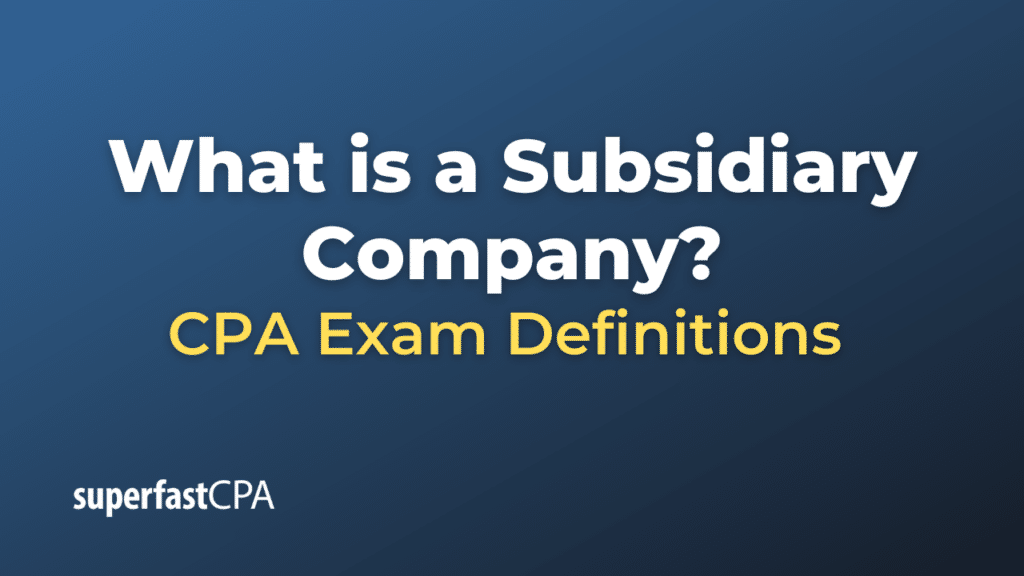Subsidiary Company
A subsidiary company, often simply called a “subsidiary,” is a company that is either wholly or partially owned by another company, known as the parent company or holding company. The parent company holds more than 50% of the subsidiary’s voting stock, giving it the right to control the subsidiary’s operations, management, and strategic decisions. The level of control distinguishes a subsidiary from other forms of business relationships, such as affiliates or associates.
Characteristics of a Subsidiary Company:
- Control: The parent company typically has a controlling interest in the subsidiary, meaning it can make decisions on behalf of the subsidiary. This control is usually due to the parent company owning more than 50% of the subsidiary’s voting shares.
- Separate Legal Entity: A subsidiary remains a separate legal entity from the parent company, with its own assets, liabilities, and legal rights. It can sue and be sued in its name, and it can conduct business independently, although often under the strategies and directions set by the parent.
- Financial Reporting: Financial results of the subsidiary are typically consolidated with those of the parent company in the parent’s financial statements. This provides stakeholders a comprehensive view of the financial health of the entire corporate group.
- Independence: Depending on the parent company’s approach and the subsidiary’s strategic importance, a subsidiary may have operational independence. Some subsidiaries maintain their branding and business processes, while others might be closely integrated with the parent.
- Ownership: Subsidiaries can be wholly-owned (100% of shares held by the parent) or partially-owned (more than 50% but less than 100% of shares held by the parent). If a parent company owns less than 100% of a subsidiary, other shareholders own the remainder, and they may have rights depending on the ownership structure and jurisdiction.
Example of a Subsidiary Company
Let’s delve into a fictional scenario to understand the concept of a subsidiary company:
Scenario: “AutoDrive Innovations & ElecMotors Co.”
Background: AutoDrive Innovations is a leading company in the autonomous vehicle technology sector. They have successfully developed software and hardware systems that can convert traditional cars into autonomous vehicles.
ElecMotors Co., on the other hand, is a rising star in the electric vehicle manufacturing industry. They are known for their efficient, eco-friendly, and affordable electric cars.
Acquisition: AutoDrive Innovations, with a vision to incorporate their autonomous technology into electric vehicles, decides to acquire a controlling stake in ElecMotors Co. They purchase 70% of ElecMotors Co.’s shares, making the latter a subsidiary of AutoDrive Innovations.
Post-Acquisition Dynamics:
- Control: With a 70% stake, AutoDrive Innovations has the right to make major decisions in ElecMotors Co., including decisions on strategy, financing, and operations.
- Separate Branding: ElecMotors Co. continues to operate under its own brand name. However, they start introducing models as “ElecMotors with AutoDrive technology,” showcasing the merger of their electric vehicle expertise with autonomous technology.
- Financial Reporting: At the end of the fiscal year, AutoDrive Innovations includes ElecMotors Co.’s financial results in its consolidated financial statements, presenting a combined financial picture to its stakeholders.
- Operational Synergies: ElecMotors Co. benefits from the advanced R&D and technology of AutoDrive. In contrast, AutoDrive gets an established platform to deploy and test their autonomous tech in real-world electric vehicles.
- Independence: While strategic decisions are now aligned with the parent company’s vision, ElecMotors Co. retains its operational processes, manufacturing units, and employee culture.
Outcome: This subsidiary relationship enables both companies to lead the market in autonomous electric vehicles, combining strengths and leveraging synergies. While ElecMotors Co. is a subsidiary and under the control of AutoDrive Innovations, it still operates in the market with its identity, backed by the technology and resources of its parent company.
This example showcases how a subsidiary relationship can be beneficial for both the parent and subsidiary companies, allowing them to collaborate, share resources, and leverage each other’s strengths while retaining individual brand identities.









